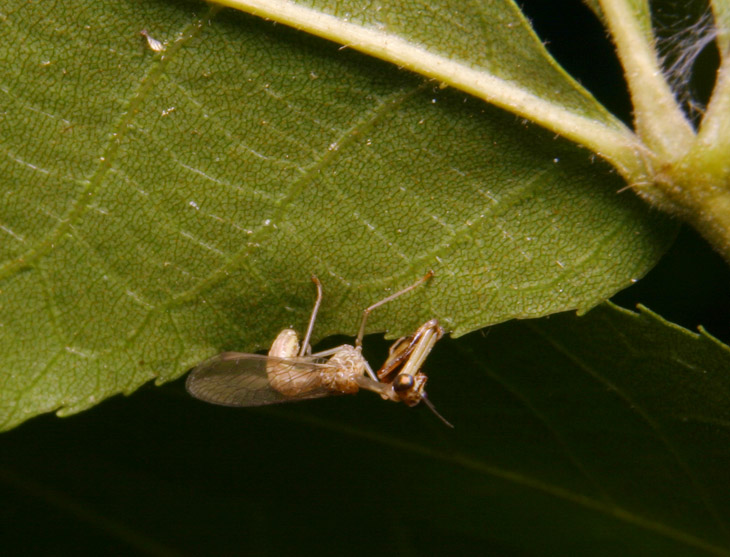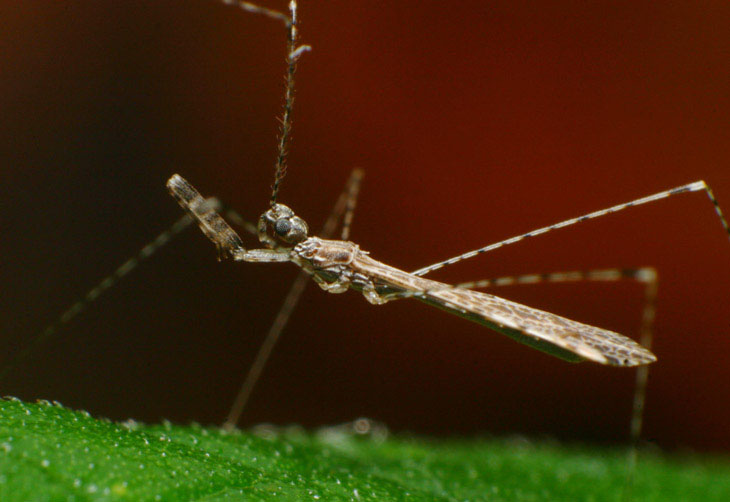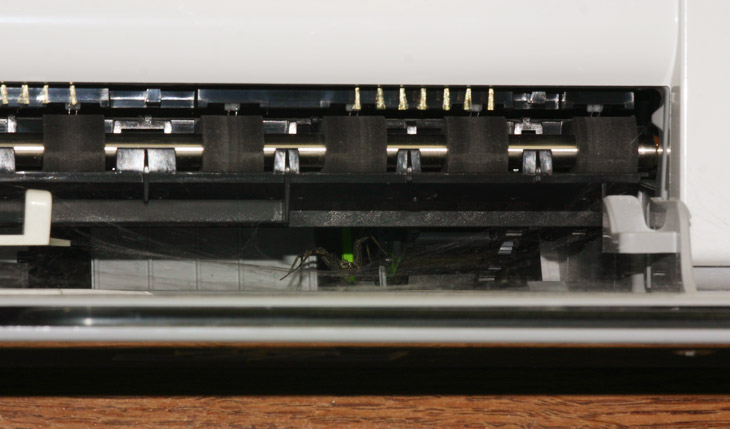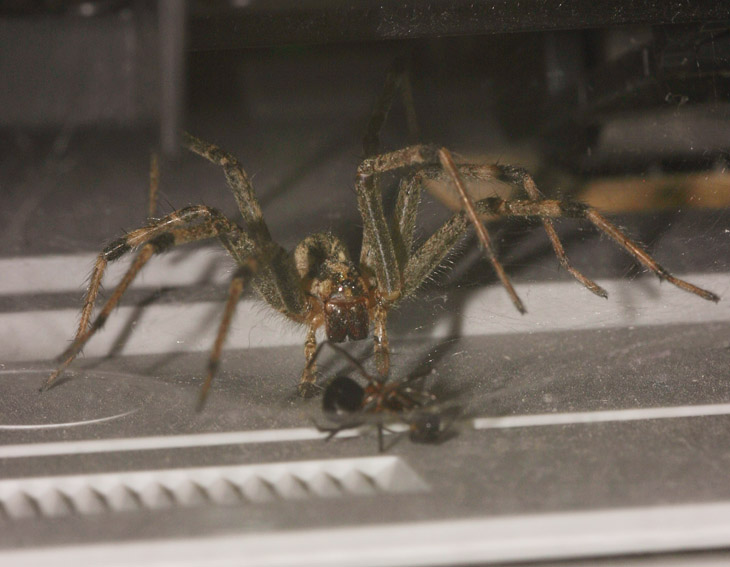I said in the previous post that more would be coming “in a day or so” after I worked out some details. “Or so” apparently means “five days.” However, that’s nowhere near how long I’ve been waiting.
Back in 2010, I snagged a pair of images of a small unknown insect, one that flew away before I could do anything detailed, and this was before I had the macro options I do now. On examining the images during sorting, I realized I’d never seen anything of the like; it looked like a cross between a lacewing and a praying mantis, less than a centimeter in length.

Without a lot to search on, I tried just using the term “mantis fly” and popped it up immediately. Almost certainly a member of the family Mantispidae, this one might well be a green mantisfly (Zeugomantispa minuta,) though the guide page doesn’t give a range of sizes; since this one had wings, I’m assuming it was a reproducing adult and not a larva. I have not seen one since – until, I thought, the other evening.

I pootered this one circling the light and was delighted when I examined it, because I thought I’d finally found another example of a mantisfly. Getting the preliminary photos was a challenge, because this one was about the size of a mosquito and showed no reluctance in flying off, so it would have to be in some kind of enclosure. Unfortunately, the only enclosure I had that would work for the short working distance of this magnification was already in use, as a terrarium housing the very spiders that this guy was initially captured to feed. I ended up lying another small aquarium on its side and shining a bright light in from the top, because I’m sneaky; while the side (formerly top) through which I was aiming the camera was wide open, the insect was attracted to the light so the two times it tried to fly off, it simply went against the acrylic above it (former side) and returned to the leaf. After the initial shots, I popped it into the spider terrarium while I tried to figure out a way to handle this more effectively.
The terrarium only has a thin bit of gauzy fabric stretched over the top, which I thought was sufficient – this post is full of mistaken assumptions. Overnight my subject disappeared, and on a subsequent night I watched several other small insects simply crawl through the openings in the fabric, so that needs to be replaced with something much finer, probably a bit of silkscreen. In the meantime I picked up four 5×7 frames from the dollar store and used the glass to make a 5x5x7 enclosure strictly for photography, and a few pieces of glass to modify other aquariums I have, because acrylic is absolute shit to shoot through. And finally, just now, I sat down to write this up and dig out the old photo you saw at top.
If you thought they looked significantly different, good eye: they’re not related, and the latter one is certainly not a mantisfly. It’s a variety of threadlegged assassin bug, indicated easily by the proboscis on the head; possibly tribe Metapterini, of the subfamily Emesinae from the family Reduviidae (of the clan Macleod – sorry.) Another variety can be seen here.
So, abruptly, I crashed into disappointment strictly from working on this post – I’m going to go ahead and blame that on you if you don’t mind. But while looking through BugGuide.net for further details on the still-elusive mantisflies, I came across this photo (part of a series that provides positive identification,) which looked remarkably familiar, so now it seems I have at least identified those eggs and larvae. This, however, is also a facet of frustration because it means that I had a hatching of the very subject I’d been looking for and didn’t realize it, nor did I ever see an adult.
Now, while searching back through the photo archives to find that mantisfly, I came across the next few images which reminded me of something I’d forgotten about. In my old place, I had an inkjet printer sitting on a hutch atop my desk, before I determined that they were complete wastes of technology and effort and switched to a laser printer, never to return. And one day I glanced up casually to come face-to-face with a spider peering at me from the print delivery slot.

This was some variety of funnel weaver, family Agelenidae, and you may well take this as a reflection of either my sporadic printer use or my terrible housekeeping abilities or perhaps that I lived in something akin to a shed, but it was none of those things. It was high summer, and yes I lived alongside a wooded area, but overall the place was clean and not overrun with spiders; this one has simply found its way in and liked the printer for some reason, and while I can’t pin down a particular time frame from when I could confirm it had not been there, this may have happened literally overnight.
The nature of funnel weavers is that they create a large horizontal sheet web that rolls up in one corner into a tube or funnel, usually in a natural niche someplace, and within this tube they spend most of their time, hidden away from predators while awaiting something to fall into their web. At times you may see one sitting out in the open sheet, but most times it will vanish into the tube at the least provocation, and the one on my desk was definitely disposed to this behavior, disappearing deep into the guts of the printer. I wasn’t really inclined to leave it there, and will readily admit that I was more than a little creeped out on my initial encounter. But how to remove it?

It didn’t take long. All I did was go out and collect a live ant to throw into the sheet, and in a flash, the spider emerged triumphantly to partake of this free meal, no doubt congratulating itself on the choice homebuilding locale. This delight was short-lived, however, because immediately after I got the photos, the shop-vac came into play before the spider could retreat away from the effective suction, and my printer was clean once again.
Getting back to the subject of flying insects and macro photography, this is something I’ve struggled with for years. Any time something can fly away, naturally getting macro photos is tricky; depending on the focal length and magnification, you might have to loom very close, and this can be enough to provoke the subject to fly off, or it may simply do so because it has no desire to march around on whatever leaf you provided. The goal is to have an enclosure where it cannot escape, and in times past I have used the bathroom (small enough to find the subject again – sometimes) and a variety of aquariums/terrariums. Since acrylic will seriously affect image quality and scratches if you breathe on it, you’ll want glass – but you also want a very short working distance so the subject cannot simply move far enough from the glass that you can’t get the magnification you’re after. This means smaller enclosures, like the 5x5x7 one I mentioned (right now just an open box that can be placed over anything, and sealed off on top by screen or another piece of glass or a book or whatever,) and perhaps even smaller – the one I’m about to modify measures something like 5×7 inches broad by about 1 inch deep, and of course there’s this one that currently houses the spiders.
It would be far better without any glass at all, since even a good piece of glass will offer some distortion if you’re not shooting straight through it, but that means some kind of booth or hood that seals off both you and the flying subject so they can’t get very far, and setting up something like that could be problematic (not to mention finding a place to put it.) Maybe someday I’ll attempt using a large wardrobe or a closet, but right now I have nothing of the sort available. But keep checking back, because I’ll be testing out the new options soon enough.




















































